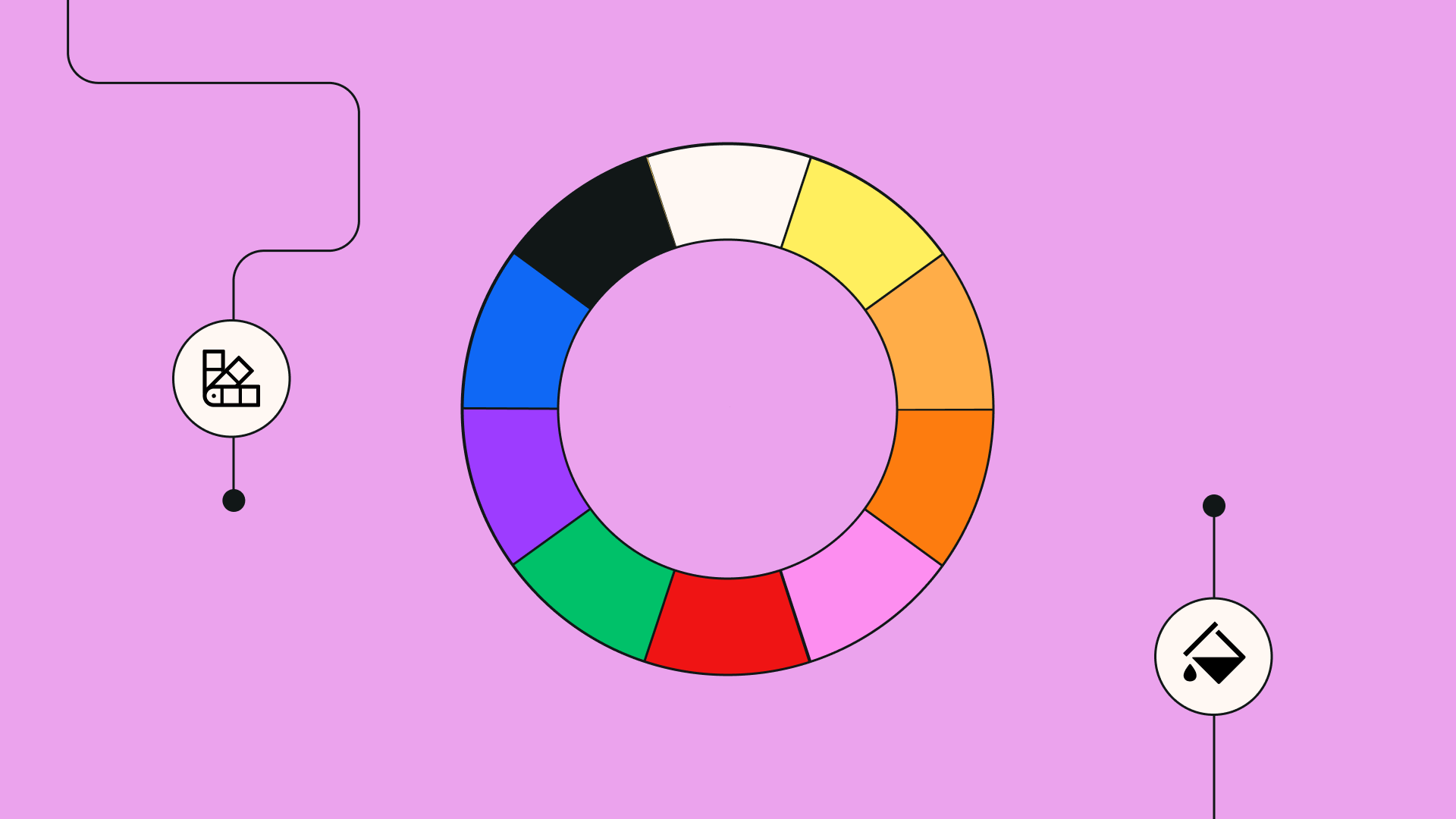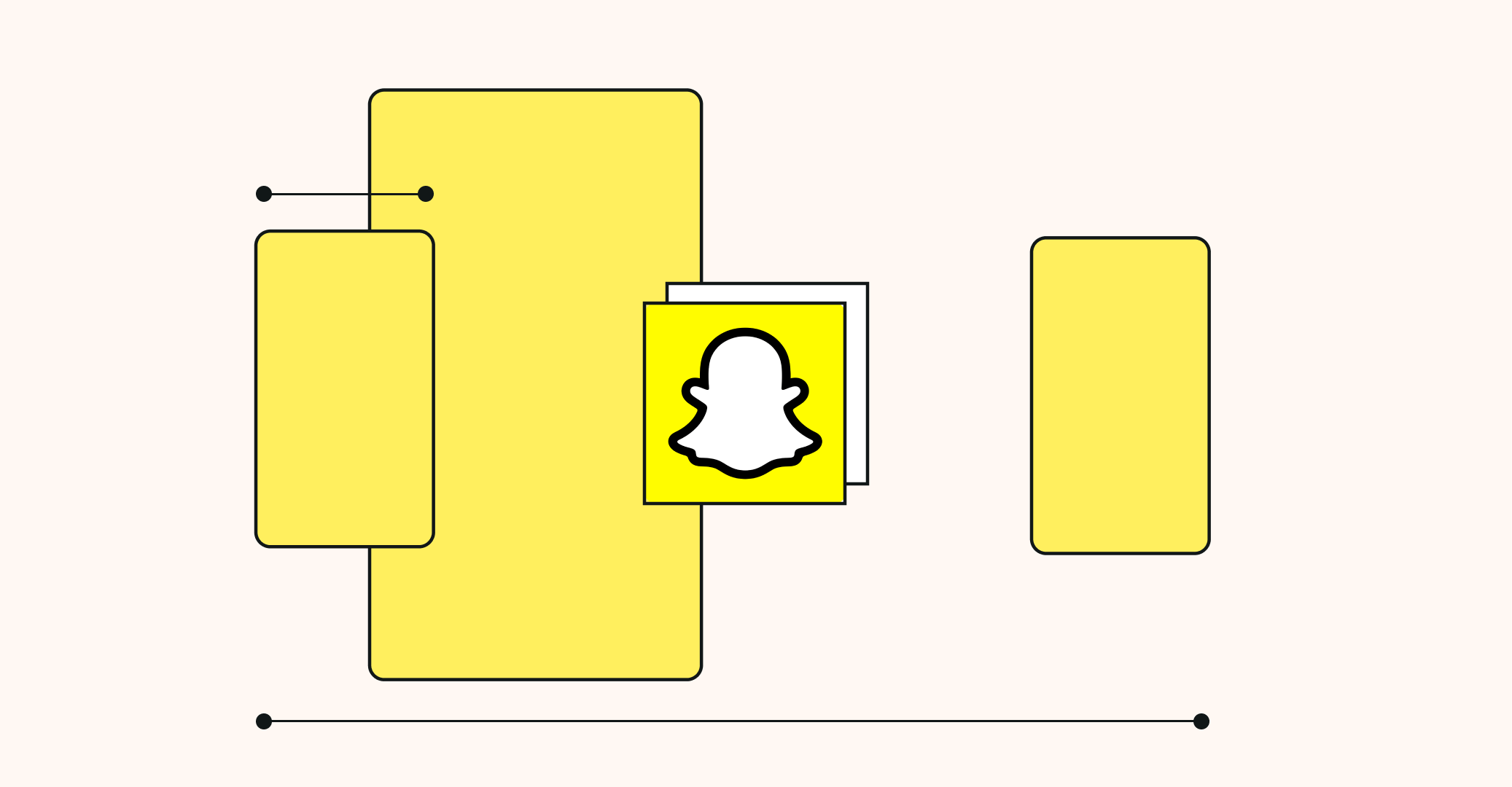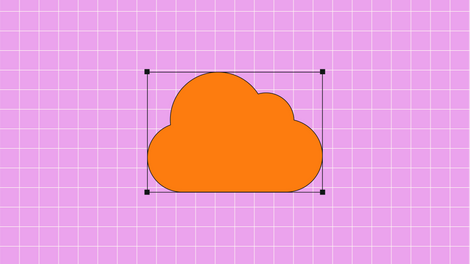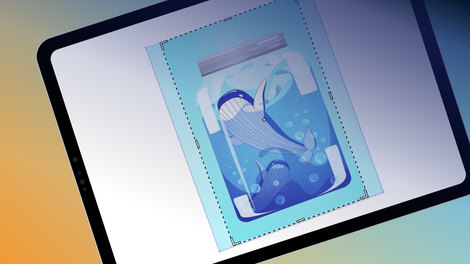Who doesn't love a classic filter added to their images and videos. No matter what mood you’re in, there’s a filter for you. Whether you want to be a dog with ears and a tongue, have a sparkling flower crown, or heart-shaped eyes, platforms like Snapchat have you covered.
But, if you’re looking to increase your following and rack up those likes, there’s a little more that goes into creating eye-catching, mouth-watering, and dollar-stacking visual content and video content for your Snapchat feed.
Let's take a dive down filter lane, shall we?
Jumpstart your ideas with Linearity Curve
Take your designs to the next level.
Where Snapchat began

Snapchat emerged almost ten years ago, and it excited everyone by letting us tell stories, use fun filters, and create ‘off-the-cuff’ organic content that would disappear in 24 hours.
It was basically the start of the well-known visual elements, such as the story format, we all know today. Because Snapchat literally made a business out of this concept, other social media platforms like Instagram, Facebook, and now TikTok have copied the basic idea and run with it, making it one of the most popular platforms.
Although Snapchat seems less and less popular these days, last year, it still recorded a whopping 319 million active users around the world.
But just where and how did filters come about?
The history of social media filters

We all tried them at least once. The inventive way to communicate with your friends and family. Yes, we are talking about filters.
The history of engaging ‘fun-to-play-with’ filters will take us to the very beginning of Snapchat. The one that introduced us to the world of dog ears. Did you know that the app was originally supposed to be called Picaboo? Little did we know that something this huge would come out of that. Later in 2012, even Android users could download this app, and the real boom of Snapchats was set up to begin. Snapchat and its animated way of connecting with people were growing. They were growing so much that even Mark Zuckerberg, founder of Facebook, wanted to buy Snapchat in 2013. Proving that if Facebook wants to buy something, it must be very good.
In 2015, Snapchat filters came out, and it was a huge game changer. Engaging with this app became even more interactive. Snapchat kept growing and working on its filters and other big players were more and more interested in acquiring this growing wonder. In 2016, Google wanted to buy Snapchat, but they were rejected.
Instagram did not want to be left out of this growing trend and launched Instagram Stories and Instagram Reels in 2016. Instagram started building blocks for its filter debut. It didn’t take long as they introduced AR filters in 2018. At first, Instagram’s AR filters weren't open to everyone, but they changed it in 2019. Anyone can now download a SPARK AR kit and work on AR filters.
Ready to create brand assets that pack a punch?
Visit our Academy for free marketing design courses.
This was a big step in the world of augmented reality and filters in general. It allows basically anyone to become a creative filter creator. It also ignites a fantastic opportunity for businesses to get closer to their followers. They can now get their own personalized filters that will reflect their brand identity and make their social media platforms more attractive. And, of course, entertaining for potential clients.
For business purposes, Snapchat ads will be especially interesting as they have the potential to reach 9% of the world's population, and that number is growing. Snapchat remains a hotspot for organic videos when it comes to sharing among the younger demographic. So, on that note, here is the first step in successfully leveraging the platform: post your content in the right aspect ratio.
Snapchat video story size
No surprise here: the original resolution video format is the most common type across the channel. While it’s mostly used between users as a way to communicate with each other through the app, you can post videos to your story. So, others can see what you’re up to (but in business terms: this allows you to promote your business, your designs, your art, and so on).
The recommended display size for a video is 1080 x 1920, which is an aspect ratio of 9:16. Your form of video cannot be longer than 10 seconds or bigger than 32MB, and it should be in .MP4 or .MOV. format.
Snapchat video ad size
If 10 seconds are not enough, then grab your credit card, because Snapchat currently offers long-form video ad formats.
The specs are the same as before: the recommended dimensions for a static image or a single image is 1080 x 1920 (the minimum image size), and your content cannot exceed 1 GB (the maximum image size). With such a maximum file size, you can showcase some high-quality material here, even if you have low-quality images.
Accepted motion video formats are .MP4 and .MOV. And the video can be a whopping 180 seconds long! Enough to tell any story if you ask us.

Snapchat shared image size
Just like Instagram Reels and Stories, snaps take up the full screen of your phone. It’s 1,080 pixels wide by 1,920 pixels tall when it comes to pixels on smartphones.
If you take a snap with your phone via the app, your cover image size dimensions will automatically be preserved as 9:16, so you don’t have to alter anything. But if you're creating an ad, then make sure to design it as specified, in jpg, jpeg, png files, or maximum file formats. Unfortunately, Gifs are not accepted as a file type, image icon, or motion graphic.

Snapchat Geofilters size
If you want to get serious with your brand (whether you’re a marketer or you're doing this for your personal profile picture), you can even create your own Snapchat filter.
More specifically, Snapchat has debuted a feature that will let anyone create their own custom Geofilter. So, you can become an integral part of the hundreds of millions of Snaps sent between friends each day. Here's what a Geofilter means: When users are in the location or locations of your choice, and they take a snap, they’ll be able to see and use your filter to jazz up their stories.
It's a pretty cool feature for events like weddings, proms, or birthdays, but it's also a fantastic opportunity for brands to generate more visibility. The recommended image size guide for a link image is 1080 x 2340, and your image feed posts should not be larger than 300 KB. The image needs at least 50% transparent areas, which makes sense because you don’t want to cover the users’ faces completely. Think of it as more of an overlay. For this reason, the only accepted format is PNG.
Be warned, as you cannot include your logo unless you have authorization. If you do have the authorization, however, there are a couple more rules to follow. You should leave a buffer zone of 310 pixels on the desktop between the top of the bottom border of your image when placing your logo, text, and any other legal disclaimers. Plus, your filter should include a clear and conspicuous logo placement. No hidden advertisement is allowed.

Snapchat profile picture

Since 2017, Snapchat quietly changed the way profile pictures and profile images work. Users cannot upload their own profile photo and header photo (or profile photo size) inside the ghost-shaped frame anymore. They are forced to use Bitmoji avatars.
It’s not a huge change on the surface, but users were outraged about it. Now, the waters are calm, and everyone accepts the fact that Bitmojis are the new status quo. No need to know any aspect ratios here. Just tap your profile photos to edit your Bitmoji. A nifty little thing about the app is that it will suggest some predefined Bitmojis based on your own appearance. Is this enough for us to forgive and forget the 2017 disaster? Totally. It’s like making a Sim all over again.
It almost goes without saying, but you won't need a cover photo, header image, channel art, a thumbnail, or any other type of visual to deck your Snapchat channel. Now that you know how to create a picture-perfect snap, let’s find out which filters are the most popular that you can consider adding to your brand, campaign, and advert design and graphic elements.
The most popular Snapchat filters

Fire sunglasses

Whenever users feel energetic and motivated, they use the ‘fire sunglasses’ filter. They want to show everyone they're on fire, and there couldn't be a better filter than this. It provides users with a pair of glasses with fire on the glass, which adds to the energy.
The fire gives you a fiery, relaxed look that catches people's attention.
Neon horns

The original filter, the devil's horn, but in neon. Incredibly catchy to the eye and gives the user a devilish look. This filter is a classic and is here to stay for a long time.
For the first time, horn filters have taken one step further and given it a neon effect, making it even more appealing. The user can now also change the horn color. Various options have been offered, such as black and white. Some more color options include lime green, magenta, orange, and light blue. Want to know the best part? It sits perfectly according to your filter and does not glitch at all.
Cartoon 3D style

Cartoon 3D style is one of the most popular filters on Snapchat and has every right to be. It gives the user that unique specific animated look making them look like they just stepped out of a Disney movie. This filter adjusts itself according to a person’s face cut and turns into Disney cartoons, such as Kristoff.
People love to fool around with funny filters, and this one here has to be the best of them all. This filter has a soft shading giving it that artistic look like it had been hand-drawn.
The best Snapchat filters from developers
The polaroid frame

This filter has to be one of the best filters on Snapchat. Moreover, it turns users’ pictures into a polaroid, and we all know how good a polaroid looks. This filter brightens up background photos and applies a few filters, softening a person’s face. It also mentions the day and date at the bottom in handwritten writing, making it even more personal.
Pecan

This filter adds a darker hue to a person’s skin and gives them a textured filter without going too far. This filter comes with two options – with grain and without grain – and most people prefer it with grain. Furthermore, this filter gives people those cool summer vibes. You can also control the amount of tan this filter adds. Most people love this filter because it's very subtle, but it does a lot without saturating colors too much.
The Dancing Turkey

It's good to be a bit goofy sometimes, and this filter is the right one for it. This filter provides you with a turkey costume, and this filter makes many laugh out loud. The turkey even shows off its excellent dancing skills.
Get creative with Linearity Curve.
All the tools you need to create post and share them with your squad.
The Elders

This filter would be beneficial around Halloween as it gives you that spooky look. You could scare people out of nowhere. It appears normal at first, but your face will change into a scary-looking nun when you open your mouth.
Distortion

This filter shows life through a different lens as it distorts your picture or video sizes against the corners of the screen. It's a filter you can use to draw focus away from something or make your post more abstract.
The Scary Mask

When people get bored with typical filters and don't get much response, they use funny or scary filters, which are way more engaging. But here's the kicker – this filter covers half the user’s face with a golden skull mask and turns their eyes into a golden flame color too.
The best default filters and lens from Snapchat
Reverse video

This is one of the most used default filters and the best option for a filter on Snapchat. You don't need to add this filter as it's already there. If you make a video type, you get an option to reverse the video resolution and make it more attractive as if you're going backward. It is an interesting way of making your videos tell a story.
Time and date overlay

This is one of the best Snapchat filters and probably the most used. Everyone uses this filter in their pictures and videos. This filter is set as default, and you don't need to install or save it. It will allow other people to know the exact date and time of the picture, exactly when it was taken.
No matter what industry you are in, you’re sure to love these filters, as well as use them to promote your business more excitingly. Besides making your ads more lighthearted, intriguing, and relatable, find out what other advantages are when using Snapchat for your adverts.
Snapchat ad benefits

Reach the youth
According to Snapchat, Millennials are emerging shoppers having a direct spending power of roughly $1 Trillion. If your brand is also targeting Gen Z, then Snapchat is your best buddy as:
- Snapchat has dedicated millennials in the age bracket of 18-34
- Each user spends an average of 30 minutes on the app daily
- 60% of active Snapchat users make impulsive purchases.
These are some serious figures you would not like to miss to skyrocket your sales.
Share user-generated content
Snapchat user-generated content images are the best. It eliminates video content creation hassles, makes them an inclusive part of your brand (initiating emotional connections with the users), and is a great way to strengthen a brand's credibility.
Multiple ad formats
Bid farewell to boring ad pitches with Snapchat. You can choose from multiple Snapchat ad formats, such as snap ads, story ads, filters, and AR lenses. Introduce features and announce giveaways with story ads. Go for snap ads giving a sneak peek of all the cool activities associated with your business. Just make sure to keep the size of your ads short and crisp with loads of exciting elements that will invoke curiosity and interest.
Snapchat insights
You can’t rely solely on the views and number of screenshots taken for building a Snapchat social media marketing strategy. That’s when Snapchat Insights come into the picture. Snapchat Insights are essential game-changers for Snapchat marketing. For one, you can learn more about your potential leads’ location and demographic data for better planning.
The key performance indicators, like view counts, daily reach, etc., will let you evaluate interest and engagement rates. There are also hundreds of categories for grouping users based on their interests, like music, movie buffs, traveling, etc.
Wrap up

When you consider Snapchat as a full-screen experience tool, there are a few ways to go wrong when it comes to the engagement rate with your users. Larger images (with a background image) or videos taken via the app are the correct and ideal aspect ratio already, and the general rule of thumb is to stick to the pre-set mobile aspect ratio of 9:16.
It can also be tough trying to bridge being entertaining on the app with being strategic as a business. However, as long as you stick to the ideal file size and pixel size formatting guidelines, you stay authentic to your brand, and you have fun doing it, you’re sure to reach your target.
If you want to expand your outreach and digital presence as a brand, or you’d like to start creating interesting experience ads and filters, be sure to check out Vectornator. We provide you with Snapchat templates so you can start making your channel memorable. But we also get you started with invaluable asset information on social media image sizes for all other social platforms, like Facebook, LinkedIn, Instagram, or Tumblr. You name it – we've covered it.
So, what are you waiting for? Go out there and snap some success for you, your team, and your business.
Jumpstart your ideas with Linearity Curve
Take your designs to the next level.
Share this!
Benjamin Barnhart
Ben is the Principal Copywriter for Linearity, living in Berlin. His hobbies include board games, cooking, reading, and writing.


:quality(75))
:quality(75))



:quality(75))

:quality(75))
:quality(75))


